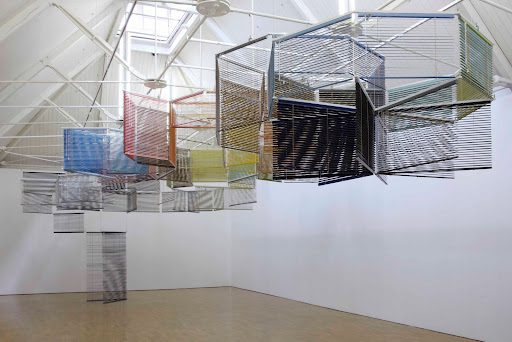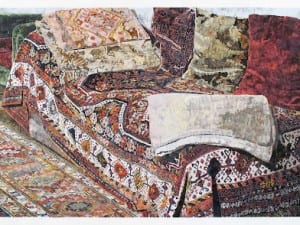Review by Lucy Hobbs
Five tomato cans, elevated on a cylindrical platform boasting tightly-knitted mauve exteriors introduce visitors to Haegue Yang’s foremost solo UK exhibition Teacher of Dance. Seoul-born Yang has been living and working in Berlin and Seoul for the past fifteen years and Teacher of Dance presents an album of over a decade of the artists work. Yang’s sculptures and installations research and formulate connections between private space and domesticity by frequently utilising and manipulating recognisable household objects and consumerist goods. Transformation of household entities is a frequent attribute in Yang’s work which reflects explicitly on her impressions of modern civilisation, society and community.
The series Can Cosies (2010) presents the artist’s most recent and on-going body of work; knitted sleeves fashioned for wholesale food tins. The consecutive loops of wool delicately embrace the monotonous 400g cans, exchanging their former appearance for a more surreal and delightful facade. They are both bulky and delicate. The rest of the lower ground floor of Modern Art Oxford showcases a miscellany of Yang’s smaller-scale works; Manteuffelstrasse 112 (2010-2011) a sequence of venetian blinds accommodating the electrics of two light bulbs and fifteen black and white photographs of a clothes airer in different positions titled Gymnastics Of The Foldables (2006). The space is ideal for these works; frames are strategically hung on temporary triangular boarding reminiscent of a late Carl Andre sculpture, whilst Manteuffelstrasse occupies a refreshingly illuminated rear corner of the room.
On entry to the bright upper gallery, a militia of bizarre structures exposes itself in a vibrant frenzy; the skeletons of numerous clothes airers bound in plains of material avidly enclose a carousel-like structure made entirely of Venetian blinds. Non-Indepliables (2006-2010) comprises of a series of drying racks encased in fabric and yarn which establish their territory in the room as though they are alive, striking poses worthy of a fitness class. These works are emblematic products of Yang’s prime influence; movement. They engage with a multitude of colours to construct a striking environment that is both playful and foreign. The strength of the room is in the deposits of shifting hues; Non-Indépliables, azuré (2009) and neon-coloured Non-Indépliables, jaune (2010) are the foremost objects to be distinguished, but after a while spent staring at knitted emerald and cerise wool, the pallid Non-Indépliables, pastel (2010) reveals itself decorously from a tucked away space.
Amongst Non-Indepliables awaits a mechanism on wheels that encourages viewers to interact with it by entering its centre and navigating it within the space. The sculpture, almost robotically, moves awkwardly whilst its geometric body of blinds swings around the individual controlling it. In contrast to the ostensibly-still knitted airers, it appears cumbersome and hectic; conceivably touching on the complexity of the artist’s existence being divided between Europe and Asia.
Following this premise, concepts of understanding domestic space, particularly insignificant space, is fluent in Yang’s practise. The video Doubles and Half’s – Events with Nameless Neighbours (2009), projected in the middle gallery, shows footage from both dilapidated Ahyun-Don and the Korean Biennale grounds. Yang primarily used this essay as research for her sculptures, documenting urbanised landscapes from both of these abandoned scenes alongside a somewhat monotonous narration. The steady-moving images are verbalised through metaphors and contemplation; Yang divulges on philosophical advancements towards abandoned environments, reflecting on the science of condensation as contact with ex-residents.
Inhabiting the entirety of the remaining room, the Piper Gallery, a dominating system of connected blinds suspends itself from the ceiling. The level at which this hexagonal-like work is observed allows visitors to monitor the influence that movement has on its horizontal slats. Whilst the impressive sculpture is ambled around, the ladders of the Venetian blinds flickers, causing a collective scrolling between the myriad of compartments. Beneath the creation stands a smaller and more interactive arrangement of blinds which demonstrates a corresponding retort to eye level and motion.
Considering Yang’s most current work, focusing particularly on the Piper Gallery commission, it is evident that the artist’s exploration into influences such as Bauhaus associate Oskar Schlemmer and spiritual teacher GI Gurdjieff has impacted the incorporation of philosophical perspectives and form. Her interventions are not only fascinating and well-constructed, but well-informed in light of historical and cultural foundations. Teacher Of Dance has isolated the fundamental potency of Yang’s studies; the ability to produce a language between the commonplace articles that build our existence, and our existence itself.
Haegue Yang: Teacher of Dance continues until 4 September.
modernartoxford.org.uk
Aesthetica Magazine
We hope you enjoying reading the Aesthetica Blog, if you want to explore more of the best in contemporary arts and culture you should read us in print too. In the spirit of celebration, Issue 41 includes a piece on Guggenheimn Bilbao where the Luminous Interval features internationally acclaimed artists such as Louise Bourgeois, Kiki Smith and Damien Hirst, ArtAngel’s new commission at MIF, Bruce Nauman’s retrospective at The Kunsthalle Mannheim and Cory Arcangel’s Pro Tools at the Whitney in NYC. You can buy it today by calling +44(0)1904 479 168. Even better, subscribe to Aesthetica and save 20%. Go on, enjoy!
Image:
Haegue Yang
Cloud, 2011
Installation. Aluminium Venetial blinds, hanging structure
Photography by Stuart Whipps
Courtesy of the artist





